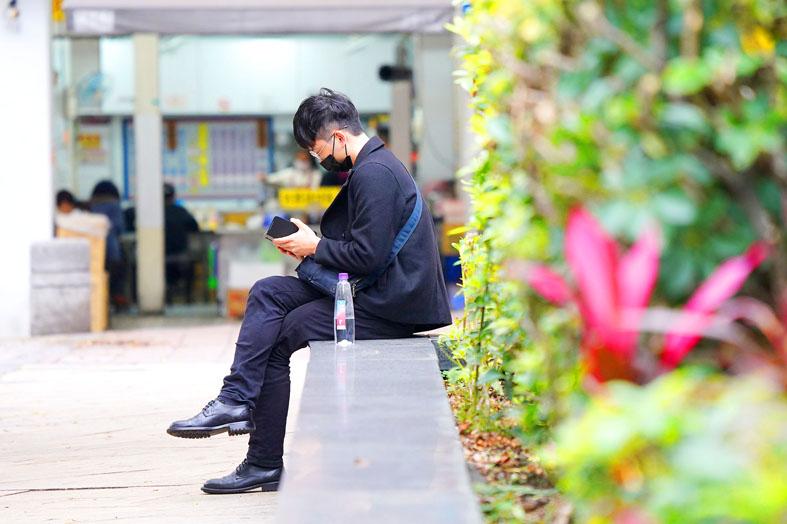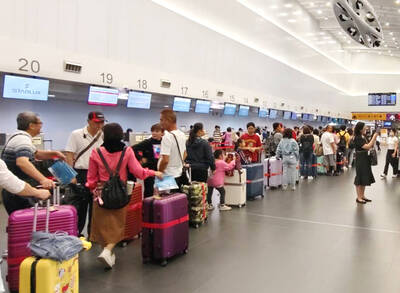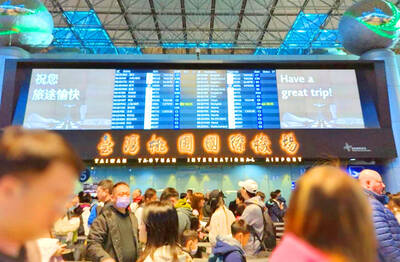Taiwan’s 5G penetration rate still remains below 25 percent after the cellular network services were launched two years ago due to a lack of “killer” applications, the National Communications Commission (NCC) said yesterday.
The penetration rate of 4G services reached 27.7 percent one year after their launch in May 2014, NCC statistics showed. By January 2016, the number of 4G service subscribers had exceeded those of 3G services, and by May 2016, the 4G penetration rate had topped 62.3 percent.
However, the penetration rate of 5G services, which were launched in July 2020, had reached 13 percent by June last year and 24.46 percent by last month. Telecoms in Taiwan estimated that the 5G penetration rate could top 30 percent by the end of this year.

Photo: CNA
Taiwan’s 4G and 5G services were launched under different circumstances, NCC Vice Chairman and spokesperson Wong Po-tsung (翁柏宗) told reporters at the commission’s weekly media briefing.
“The rapid migration from 3G services to 4G services was boosted by the popularity of smartphones, which in turn created demand for faster mobile Internet services,” Wong said.
“When it was time to upgrade to 5G services, most of the 4G users had been used to unlimited data services by paying only NT$599 or NT$699 per month. The 5G system might offer subscribers faster Internet access, but without ‘killer’ applications, it would take a while for 5G penetration rates to rise,” he said.
However, Taiwan’s 5G penetration rate is one of the highest in comparison to those of Japan, South Korea, China and the US, Wong said.
Subscribers of 5G services in South Korea, which launched 5G services in 2019, accounted for 45 percent of the country’s population as of May, Reuters reported.
In 2020, a report published by a South Korean lawmaker showed that more than 560,000 telecom users downgraded from 5G services to 4G services.
Since 2020, the NCC has spent approximately NT$15.5 billion subsidizing telecoms to build base stations for 5G services and assist businesses in building private networks using the 5G system, it said, adding that the funding came from a budget earmarked for the Forward-Looking Infrastructure Development Project.
Taiwan currently has 5,335 5G base stations, with 5G signal covering 95.56 percent of the nation’s population. Its coverage exceeds the previous goal of reaching 60 percent of the population, NCC data showed.

Three Taiwanese airlines have prohibited passengers from packing Bluetooth earbuds and their charger cases in checked luggage. EVA Air and Uni Air said that Bluetooth earbuds and charger cases are categorized as portable electronic devices, which should be switched off if they are placed in checked luggage based on international aviation safety regulations. They must not be in standby or sleep mode. However, as charging would continue when earbuds are placed in the charger cases, which would contravene international aviation regulations, their cases must be carried as hand luggage, they said. Tigerair Taiwan said that earbud charger cases are equipped

Foreign travelers entering Taiwan on a short layover via Taiwan Taoyuan International Airport are receiving NT$600 gift vouchers from yesterday, the Tourism Administration said, adding that it hopes the incentive would boost tourism consumption at the airport. The program, which allows travelers holding non-Taiwan passports who enter the country during a layover of up to 24 hours to claim a voucher, aims to promote attractions at the airport, the agency said in a statement on Friday. To participate, travelers must sign up on the campaign Web site, the agency said. They can then present their passport and boarding pass for their connecting international

Temperatures in northern Taiwan are forecast to reach as high as 30°C today, as an ongoing northeasterly seasonal wind system weakens, the Central Weather Administration (CWA) said. CWA forecaster Tseng Chao-cheng (曾昭誠) said yesterday that with the seasonal wind system weakening, warmer easterly winds would boost the temperature today. Daytime temperatures in northern Taiwan and Yilan County are expected to range from 28°C to 30°C today, up about 3°C from yesterday, Tseng said. According to the CWA, temperature highs in central and southern Taiwan could stay stable. However, the weather is expected to turn cooler starting tonight as the northeasterly wind system strengthens again

Taiwan sweltered through its hottest October on record, the Central Weather Administration (CWA) said yesterday, the latest in a string of global temperature records. The main island endured its highest average temperature since 1950, CWA forecaster Liu Pei-teng said. Temperatures the world over have soared in recent years as human-induced climate change contributes to ever more erratic weather patterns. Taiwan’s average temperature was 27.381°C as of Thursday, Liu said. Liu said the average could slip 0.1°C by the end of yesterday, but it would still be higher than the previous record of 27.009°C in 2016. "The temperature only started lowering around Oct. 18 or 19